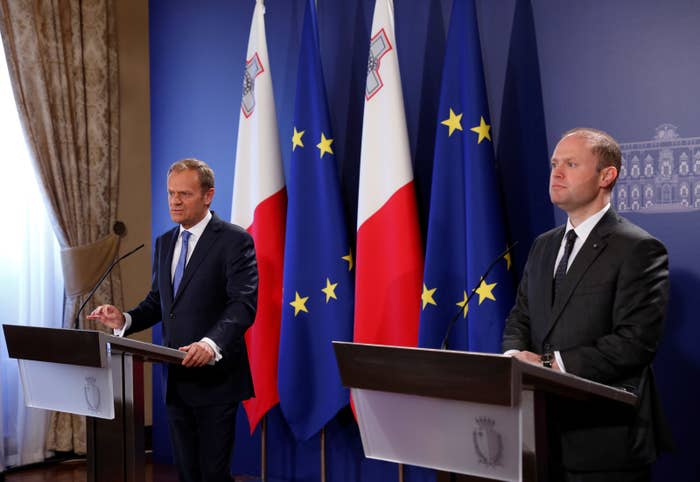
The European Union’s remaining 27 member states have set out a first draft of their Brexit negotiating guidelines.
The guidelines “define the framework for negotiations under Article 50 of the Treaty of the European Union” and set out the overall positions and principles that the EU will pursue throughout the negotiation.
They stress that the 27 will act as one, through agreed channels – together the member states set the negotiating mandate, and the European Commission's Michel Barnier and his team negotiate within that framework. There will be no separate negotiations between individual member states and the UK.
These are the key points in the draft guidelines, and what they mean in practice:
1. Exit terms must be agreed before there is any talk of a trade deal
The guidelines make clear from the outset that the 27 member states want negotiations to be phased, and for priority to be given to an orderly withdrawal.

2. The withdrawal deal will be concluded as a single package
The guidelines state that “nothing is agreed until everything is agreed, individual items cannot be settled separately”. Simply put, this implies that matters such as the rights of EU nationals living in the UK, and of Britons living elsewhere in the EU, will only be well and truly settled once an overall exit deal is concluded even if both parties may agree on how to handle any one specific issue.
This is described as a core principle in the document, meaning it will carry throughout the negotiations.
3. “No cherry picking” in the single market applies to interim arrangements too
Another core principle is “preserving the integrity of the single market”. The guidelines rule out a sector-by-sector approach to the single market, and state that the four freedoms (of movement of goods, services, people, and capital) of the single market are indivisible – and there can be no "cherry picking".
The UK has of course ruled out remaining in the single market, but this point remains important because the document later says that these core principles will also apply to any interim arrangement, as well as influencing the type of trade deal that will be possible.

4. Member states will decide when talks can progress
The document is clear that negotiations will be phased, and priority goes to the terms of departure: “The main purpose of the negotiations will be to ensure the United Kingdom's orderly withdrawal so as to reduce uncertainty and, to the extent possible, minimise disruption caused by this abrupt change.”
The first phase of talks will address the disentanglement of the UK from the union, including dealing with Britain's existing commitments to the EU; providing clarity and legal certainty to EU citizens, businesses, and other stakeholders; and coming up with "creative and flexible" solutions to avoid a hard border between Northern Ireland and Ireland.
In one of the most significant paragraphs of the document, the guidelines state that it will be for the 27 member states to determine when the next phase of talks can begin.
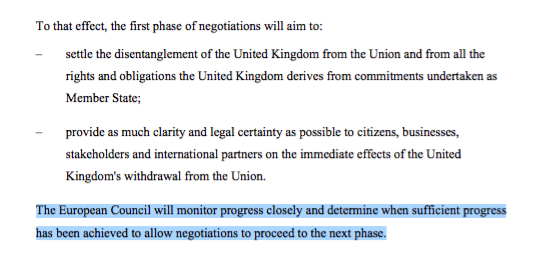
5. Initial trade talks can begin in the second phase
Though a trade agreement can only be concluded once the UK has formally exited the EU, the guidelines state that once the first phase is cleared, the next phase of negotiations can scope out an understanding of a framework for the future UK–EU relationship.
6. A transitional arrangement is possible, but it comes with strings attached
The document makes reference to a potential transitional arrangement to bridge between withdrawal and the new relationship. But any such deal will need to be clearly defined, limited in time, and subject to effective enforcement mechanisms – and “would require existing Union regulatory, budgetary, supervisory and enforcement instruments and structures to apply,” the guidelines read.

This is another significant passage of the text because it makes clear that a transitional deal would probably require the UK to continue abiding by EU rules and principles, including freedom of movement, and remain under the purview of EU law and the European Court of Justice. Politically, this could prove tricky for Theresa May as her vision for Brexit prioritises ending freedom of movement and the jurisdiction of the ECJ as soon as possible.
7. Withdrawal arrangements must be legally robust
Member states want to have legal certainty around the agreement on the withdrawal arrangement. For example, guarantees to protect EU nationals' rights must be “must be enforceable and non-discriminatory”. This means that nationals of all EU member states must be treated equally. The document also implies that the EU will seek to guarantee the rights of EU citizens' family members, as well as agreeing a cut-off point for future arrivals. All these points will have to be settled as part of the initial stage of talks.
Meanwhile, UK businesses trading with the EU, and EU businesses operating in the UK, should not be left in a legal vacuum. And the agreement on Britain’s financial and budget commitments should cover all legal and budgetary commitments as well as liabilities, including contingent liabilities.
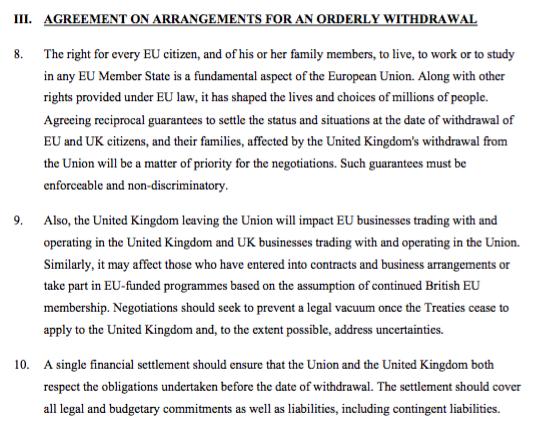
In short: Closing the first phase of talks will be more complicated than a blanket "everything will be fine" form of assent.
The EU reiterates its continued support for the peace settlement in Northern Ireland, and pledges to protect it and work to avoid a hard border, as a matter of paramount importance. “In view of the unique circumstances on the island of Ireland, flexible and imaginative solutions will be required, including with the aim of avoiding a hard border, while respecting the integrity of the Union legal order,” the document reads.
Later in the document, there is a demand to include appropriate dispute settlement mechanisms regarding the application and interpretation of the withdrawal agreement, including arrangements to deal with situations not foreseen in the withdrawal agreement. Whatever solution is negotiated should be compatible with the EU’s legal order.

8. The UK is likely to lose the benefits of the EU’s free trade agreements
The draft guidelines would appear to imply that once Britain leaves the EU it will no longer be a participant in dozens of EU free trade agreements (FTAs). The document, though, leaves options open as to how these, and other arrangements that involve non-EU countries, could be dealt with.
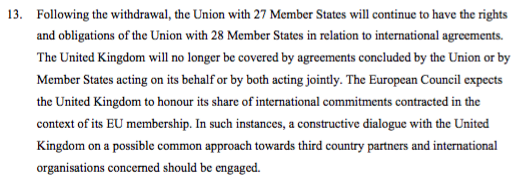
The document also states the obvious: Agencies currently based in the UK, like the European Medicines Agency, will relocate.
9. A trade deal cannot amount to staying in the single market
The EU shares the UK’s desire to establish a close partnership and wants a trade agreement that is balanced, ambitious, and wide-ranging. However, such an arrangement cannot offer the same benefits as membership nor amount to participation in the single market or parts of it.
In terms of what a trade deal might look like, the guidelines provide some hints of matters that member states will look at to ensure a level playing field “in terms of competition and state aid, and must encompass safeguards against unfair competitive advantages through, inter alia, fiscal, social and environmental dumping”.

10. Building a partnership that goes beyond trade
Echoing points made by both the UK and member states, the European Council document says that constructive ties will remain in both sides' interests and should encompass more than just trade. Still, partnerships in other areas, like the fight against terrorism and international crime as well as security and defence, have been decoupled, in choice of words at least, from a trade deal.

11. Until the UK leaves the EU it remains a full member (but will have some flexibility)
The guidelines conclude with a section on the principle of sincere cooperation: Until the UK leaves the EU it remains a member of the EU subject to all rights and obligations.
However, the document does recognise that in these circumstances the UK will need some flexibility, for example when engaging with non-EU states to talk about future trade relationships. At the same time, the 27 expect the UK to understand that they will need to meet to discuss post-Brexit matters as well as the fact that there is ongoing EU business that must continue smoothly.
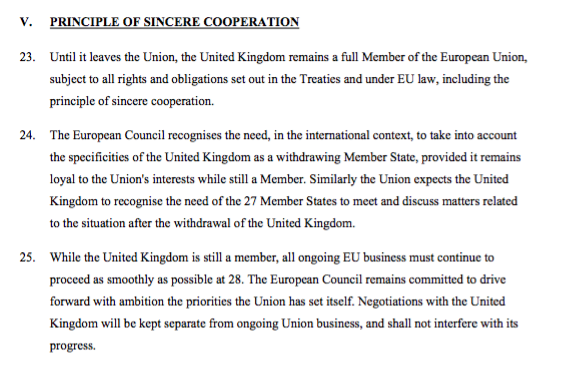
Over the course of the next few weeks, member states will consult on tweaking the guidelines before agreeing a final version at a summit in Brussels on 29 April. The guidelines are then firmed up into negotiating directives. Negotiations proper are expected to begin around the end of May.
The exit deal will require approval of a qualified majority in the European Council, while a trade agreement is likely to need the unanimous backing of member states as well as ratification by national parliaments.
